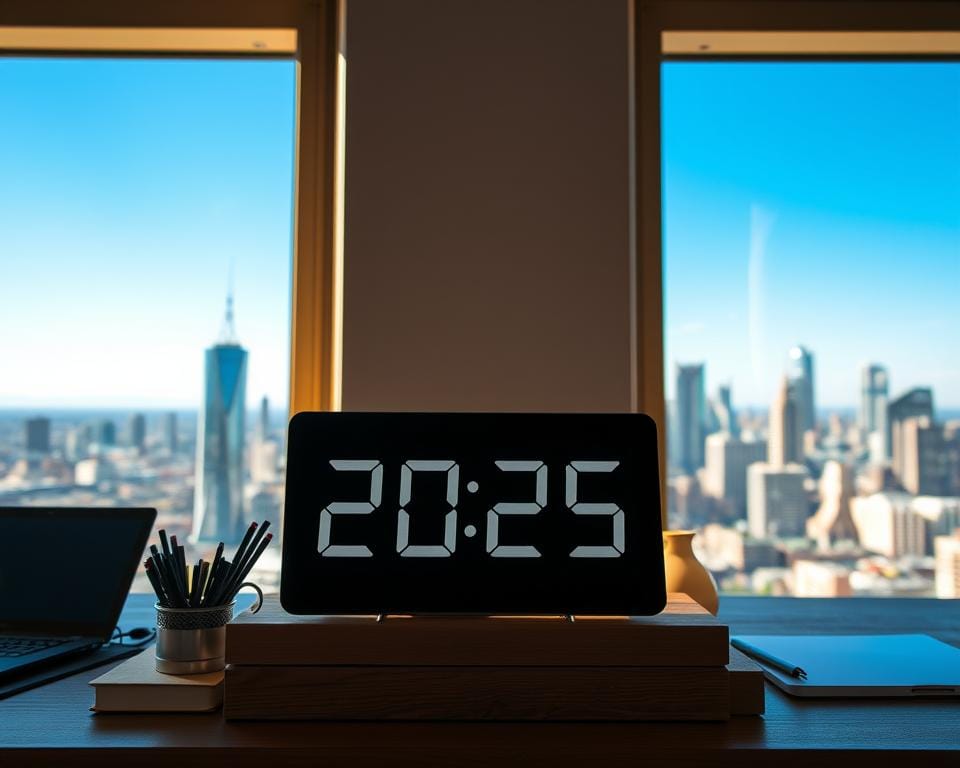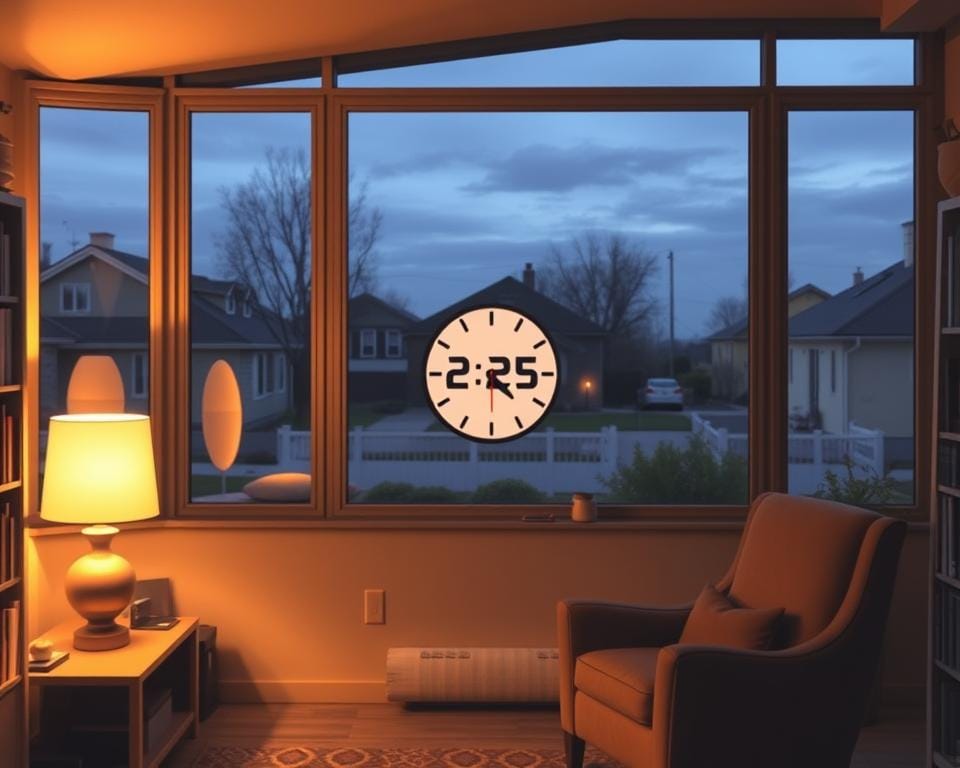Table of Contents
As we get closer to daylight saving time 2025, we’re here to share important dates, facts, and tips. Daylight saving time starts on Sunday, March 9, and ends on November 21. We’ll talk about how it works, its benefits, and what you can expect from this article.

Daylight saving time in the U.S. will begin on March 9, 2025, and end on November 2, 20252. We’ll look into its history, its effect on our daily lives, and offer tips for adjusting to the time change. Daylight saving time starts on the second Sunday in March and ends on the first Sunday in November3.
Key Dates for Daylight Saving Time 2025
As we get closer to dst 2025, remember to mark your calendar. The spring forward and fall back dates are important. Dst 2025 starts on March 9 and ends on November 24.
This rule applies to most states in the U.S. But Arizona and Hawaii don’t follow daylight saving time.
The idea of spring forward and fall back might seem tricky. But it’s key to know how these changes affect us. When we spring forward, we lose an hour of sleep. And when we fall back, we gain an hour.
This one-hour change can mess with our sleep, work, and health.
Here are the main dates for dst 2025:
- March 9: Spring forward – clocks move forward one hour
- November 2: Fall back – clocks move back one hour
Understanding the One-Hour Shift
As we get closer to the time change 2025, it’s key to grasp why we shift our clocks by an hour. This change has a rich history tied to World War I, when Germany first introduced it in 1916. The U.S. followed suit in 1918. Now, many European countries, like France, Italy, and the U.K., also observe daylight saving time.
Studies show that the time change affects our health and daily routines. For instance, a 2020 study revealed that daylight saving time increases fatal traffic accidents by 6%. It also disrupts sleep, causing people to lose about 40 minutes of sleep on the Monday after the change in March. Some effects include:
- Increased risk of heart attacks and strokes.
- Higher risk of mood disturbances and hospital admissions.
- Loss of sleep and cumulative sleep debt.

As we prepare for the time change 2025, understanding the impact is vital. We must adjust to the new schedule. Being aware of these effects helps us take steps to ease the transition.
The History Behind Daylight Saving Time
As we near the daylight saving time history in the United States, it’s key to grasp its origins. Germany was the first to adopt DST in 1915 during World War I. The U.S. followed on March 31, 1918, also during World War I. DST lasted about 7 months in the U.S. before being dropped in 1920.
The modern DST rules started with the Energy Policy Act of 2005, effective in 2007. This law aimed to save energy by making DST longer. In 2025, DST starts on March 9 at 2:00 A.M. and ends on November 2 at 2:00 A.M. About 70% of U.S. states and territories follow Daylight Saving Time.
Here’s a quick look at the dst 2025 schedule:
- Starts on the second Sunday in March
- Ends on the first Sunday in November
- Clocks are turned forward 1 hour in the spring
- Clocks are turned back 1 hour in the fall
The story of DST is filled with changes and shifts over time. Knowing the daylight saving time history and its effects on us is vital as we look ahead to the dst 2025 schedule.
How Daylight Saving Time 2025 Affects Your Daily Schedule
As we get closer to daylight saving time 2025, it’s key to know how it will change our daily lives. The dates for DST 2025 are March 9 and November 2. It’s important to know these facts to adjust our schedules right. We’ll lose one hour of sleep, which might affect our work and health.
DST 2025 will also change how we sleep. The American Academy of Sleep Medicine says sleep loss can lead to heart disease, brain decline, and obesity. To adjust well, we need a regular sleep schedule and a good sleep environment. Here are some tips:
- Slowly change your sleep schedule a few days before the time change
- Keep your sleep routine the same, even on weekends
- Avoid caffeine and screens before bed
It’s also worth noting that some places don’t follow DST. For example, Arizona and Hawaii don’t, while over 60% of countries worldwide stick to standard time all year. Knowing these dates and facts helps us plan our days better.

By understanding DST 2025’s impact and adjusting our schedules, we can reduce disruptions. This helps us stay healthy and well. As we deal with DST 2025, staying updated on facts and dates is crucial12.
Health and Safety Impacts of Time Changes
When we spring forward or fall back, our bodies adjust to the new sleep schedule. This can have big health effects. The time change can mess up our sleep patterns, leading to sleep deprivation and other problems.
About one-third of Americans don’t like the twice-yearly time changes. And 63% of Americans want to get rid of daylight saving time altogether.
Studies show that the time change in March can lead to more strokes and heart attacks. The start of Daylight Savings Time (DST) is on March 9th, 2025. Research says fatal car crashes go up by about 6% the week after DST starts.
Sleep loss affects more than just driving. It also impacts workplace safety, mainly in risky jobs like construction and healthcare.
Some important stats on the health and safety impacts of time changes include:
- Average of 3.6 more injuries occur on the Mondays following DST compared to other days.
- 24% increase in heart attack rates on the Monday after the DST change.
- Teenagers are hit hard by sleep loss due to the time change. The shift in melatonin release during puberty delays their natural sleep signals.

It’s crucial to know these health effects and take steps to lessen them, during the spring forward and fall back periods13. By understanding the risks, we can prepare better and reduce the negative impacts on our health and safety.
Preparing Your Home for DST Changes
As we get closer to the time change 2025, it’s key to get our homes ready for the dst 2025 changes. We need to update our digital devices and do safety checks for a smooth transition. Studies show that DST can raise the risk of heart attacks, stroke, and accidents.
To avoid problems, start by setting your digital devices to the new time. It’s also important to check your safety gear, like smoke alarms and carbon monoxide detectors. A survey showed that 61% of Americans want to stop changing their clocks twice a year.
Here are some tips to get your home ready for DST changes:
- Update your clocks and digital devices to reflect the new time
- Test your smoke alarms and carbon monoxide detectors
- Check your thermostat and adjust the temperature settings as needed
- Plan ahead and adjust your sleep schedule to minimize disruptions
By following these tips and being aware of the time change 2025 and dst 2025 changes, we can make the transition smoother. This way, we can avoid any big disruptions to our daily lives.
| Tip | Description |
|---|---|
| Update clocks | Reflect the new time to avoid confusion |
| Test safety devices | Ensure smoke alarms and carbon monoxide detectors are working properly |
| Adjust thermostat | Update temperature settings to reflect the new time |
Economic Effects of Daylight Saving Time
The debate on daylight saving time’s economic effects is ongoing. Some believe it boosts the economy, while others see little benefit. Daylight saving time history shows energy savings are tiny, sparking questions about its overall economic impact.
Extended daylight hours might increase spending in retail and hospitality, studies suggest. Yet, the rise of online shopping could reduce this benefit. The economic effects of daylight saving time are complex and need more study.
The retail industry is significantly affected by daylight saving time. Retailers believe longer evenings lead to more shopping after work. But, economists point out that online shopping might limit these benefits. The image below shows how daylight saving time could influence consumer behavior:
In summary, the economic effects of daylight saving time are still debated. Some see benefits, while others doubt them. More research is essential to grasp its full economic impact and how it affects different industries.
Common Myths and Misconceptions About DST
As we get closer to dst 2025, it’s key to know the truth about daylight saving time. Many myths and misconceptions surround it. It’s important to understand the facts behind these myths.
One myth is that dst saves a lot of energy. But studies show the energy savings are small, about 1% in spring and fall.
Another myth is that dst affects the agriculture industry a lot. But data shows it’s not as big of an impact as thought. Some studies even say dst can increase energy use in some industries.
It’s also worth noting that some states, like Hawaii and Arizona, don’t follow dst. Their energy use is not much different from states that do.
Here are some common myths and misconceptions about dst:
- dst saves a significant amount of energy
- dst has a significant impact on the agriculture industry
- dst leads to improved health and safety
In reality, dst’s effects on energy, agriculture, and health are more complex. As we prepare for dst 2025, it’s crucial to know the real effects.
By looking at dst data and research, we can better understand its effects. Whether you support dst or not, it’s important to know the facts. This helps us make informed choices about our daily lives and the environment.
States and Territories Exempt from DST
As we get closer to daylight saving time 2025, it’s key to know not all places in the U.S. change their clocks. Hawaii and Arizona (except for the Navajo Nation) don’t follow daylight saving time 2025. Also, five U.S. territories like Puerto Rico and Guam don’t observe daylight saving time.
Hawaii doesn’t need to change its clocks because it’s near the equator. Arizona chose not to in 1968 because of its hot desert and the energy saved from not changing clocks.
Even though some places don’t follow daylight saving time 2025, there’s talk about changing it. Many Americans want to keep or get rid of daylight saving time.
In summary, knowing which places don’t follow daylight saving time 2025 helps with planning. The ongoing debate on daylight saving time is something to watch.
Smart Technology and Automatic Time Changes
Smart technology helps us adjust to new schedules easily. It makes sure we don’t miss a beat. DST starts at 2 a.m. on March 9, 2025, and ends at 2 a.m. on November 2, 2025. This info is key for our devices to switch to the new time.
Smart tech lets us change our daily plans. We can set alarms, calendars, and reminders to fit the new schedule. Smart thermostats adjust the temperature for better energy use and comfort. Smart home devices also adjust lights and appliances to fit our new routine.
Using smart tech for time changes has many benefits. It makes life easier, saves energy, and boosts productivity. It helps us stay on track without hassle.
- Increased convenience and ease of use
- Improved energy efficiency and cost savings
- Enhanced productivity and reduced disruptions
Smart tech makes the most of our new schedule. It’s vital to keep up with tech trends to manage our lives better.
Smart tech and automatic time changes are key to our daily lives. They help us live more efficiently and comfortably. With the right tech, we can handle DST’s challenges and enjoy the new schedule.
Conclusion
The key dates for Daylight Saving Time (DST) in 2025 are March 9 for the spring forward and November 2 for the fall back. DST started in the U.S. on March 31, 1918, to save fuel during World War I. Over time, people’s views on DST have changed, with some wanting to keep it and others preferring standard time.
DST has both supporters and critics. It can lead to a 7% drop in robberies and a 27% decrease in evening robberies. Golf and barbecue industries also see big profits from the extra daylight. But, changing clocks costs Americans $1.7 billion in lost time.
As we get ready for the 2025 time change, knowing the facts is key. Understanding DST’s history and effects helps us adjust better and enjoy the extra daylight.
FAQ
What is Daylight Saving Time (DST) and why is it important?
Daylight Saving Time (DST) means we set our clocks forward by one hour in spring and summer. This lets us enjoy more daylight in the evenings. It helps match daylight with our daily activities, which can save energy and improve safety and health.
When does Daylight Saving Time 2025 begin and end?
DST 2025 starts on March 9, 2025, when we move our clocks forward. It ends on November 2, 2025, when we move them back. The effect on your time zone depends on where you live.
Why do we have to adjust our clocks by one hour for Daylight Saving Time?
We adjust our clocks to match daylight with our daily lives. This way, we have more daylight in the evenings during warmer months. It’s a way to save energy and support daily activities.
What is the history behind Daylight Saving Time?
DST started in the U.S. during World War I to save resources. Since then, it has changed and been adopted differently around the world. Its history involves key figures, laws, and debates about its benefits and drawbacks.
How does Daylight Saving Time 2025 affect my daily schedule?
The time change can mess up our routines, affecting sleep, work, and fun. Knowing this, we can adjust our lives slowly before the change. This helps us adapt better.
What are the health and safety risks associated with the Daylight Saving Time change?
The time change can disrupt sleep, increase accidents at work, and affect mental health. It’s important to be aware of these risks. We should focus on getting enough sleep, keeping workplaces safe, and seeking help for mental health issues.
How can I prepare my home for the Daylight Saving Time changes in 2025?
To get your home ready, update digital devices and check safety features. This includes changing batteries and testing smoke alarms. It ensures your home is safe and ready for the time change.
What are the economic effects of Daylight Saving Time?
DST can change how we use energy, shop, and work. The exact effects are complex and debated. Understanding these can help us prepare for the time change.
Are there any myths or misconceptions about Daylight Saving Time?
Yes, many myths exist about DST, like energy savings and health effects. It’s important to rely on facts to understand DST better.
Are there any states or territories that are exempt from Daylight Saving Time?
Yes, Hawaii and most of Arizona don’t follow DST. These exemptions are based on location and culture.
How can smart technology help with the Daylight Saving Time changes?
Smart technology, like connected devices, can make the time change easier. They can automatically adjust settings. This helps us navigate the change smoothly.










